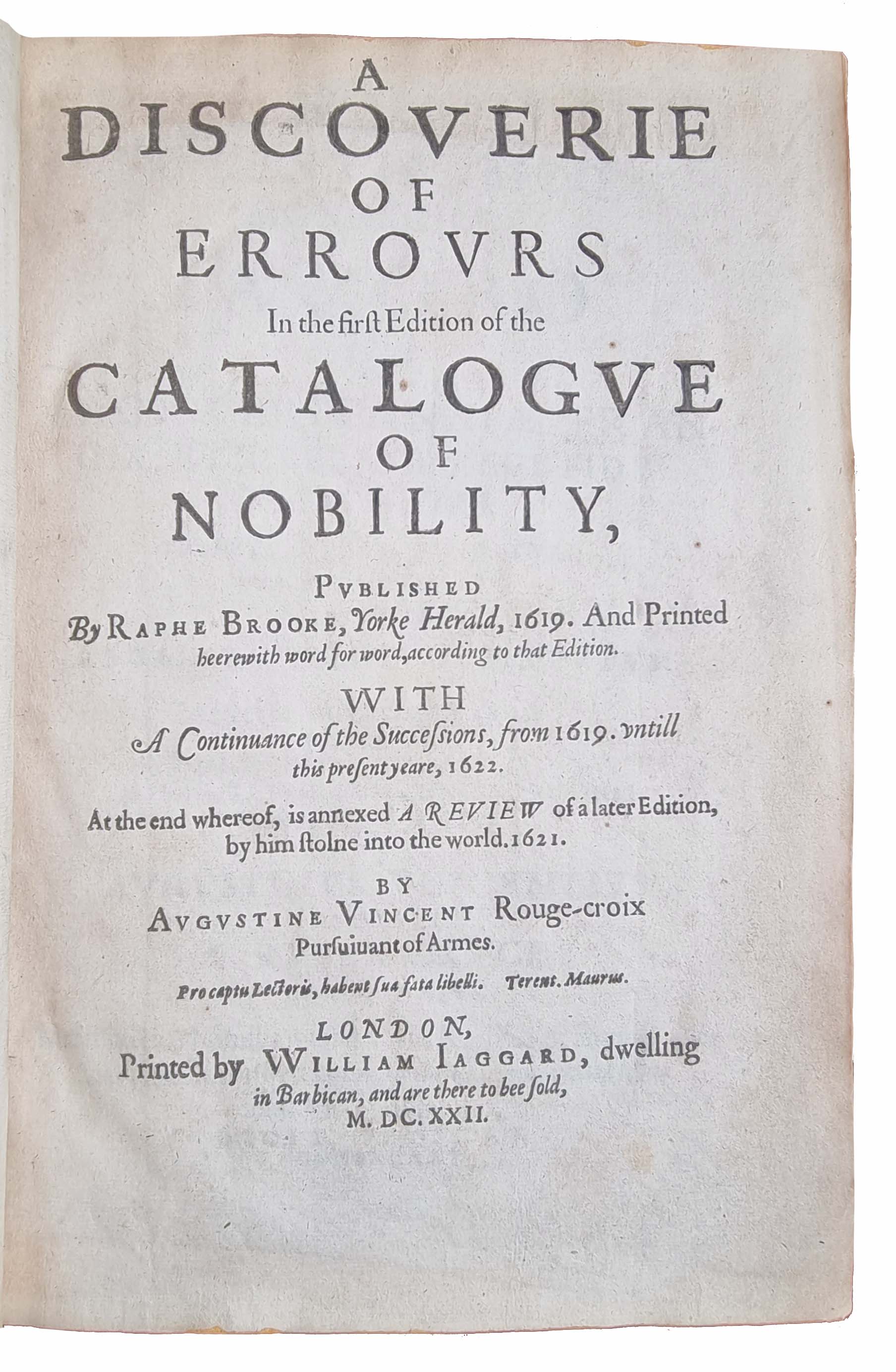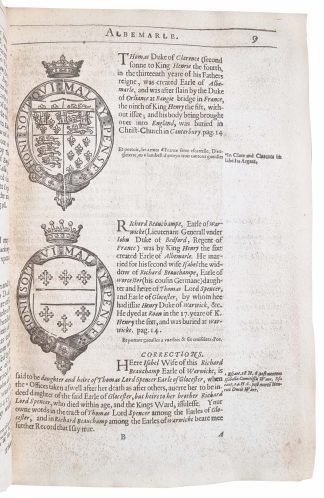VINCENT, Augustine.
SIBLING TO THE FIRST FOLIO
A Discoverie of Errours in the First Edition of the Catalogue of Nobility.
London, William Jaggard, 1622.£2,250.00
FIRST EDITION. Small folio. pp. [46], 717, [3], first blank, numerous errors in pagination. Roman letter, some Italic or Black letter. Over 600 small woodcut shields of the English nobility or medieval seals, decorated initials and ornaments. Type ink mark to Ssss2, very light age browning, occasional slight marginal foxing, tear without loss to added leaf (between Tt2-Tt3) repaired, light browning from binding glue to outer margins of last two ll. A very good, clean copy in contemporary English sprinkled calf, double blind ruled, ms Latin document in English chancery hand c.1607-8 used as spine lining (stubs visible), joints and head and foot of spine repaired, corners worn (minor restoration), couple of minor stains to upper cover, 4-line C17 ms note to ffep and few ms glosses to initial ll., unidentified c.1800 armorial bookplate to verso of first blank.
A very good, clean copy of the first edition of this important work on English heraldry, complete with the uncommon 4 cancel leaves. At the time Vincent’s work was printed, the printer William Jaggard was also working on Shakespeare’s First Folio (1623); indeed, ‘Discoverie’ ‘shares with Shakespeare’s volume a variety of printer’s ornaments and the decorative woodcuts’ (Mays, p.49). A fine copy.
The only publication of the herald and antiquary Augustine Vincent (c.1584-1626), it was the result of a 30-year quarrel, between factions at the College of Arms. Vincent sided with William Camden, Clarenceux King of Arms; in the opposing faction was York herald Ralph Brooke (1553-1625), author of ‘A Discoverie of Certaine Errours Published in Print in the Much Commended “Britannia”’ (1597), a criticism of Camden’s addition of genealogies in the fourth ed. of his famous work. Vincent’s ‘Discoverie’, mimicking Brooke’s title, detailed errors made by Brooke in his ‘Catalogue and Succession’ of kings, princes and the peerage of England (1619). Vincent reproduces the text of Brooke’s erroneous passages concerning the arms of specific figures, organised alphabetically by title (e.g., Albemarle, Bath, Norfolk, Suffolk, etc.). Each passage is illustrated by a woodcut shield, and at the end are Vincent’s detailed corrections, which focus on biographical information (e.g., wrong year of death, wrong year of appointment, wrong wife or child) or genealogical descents (e.g., omission of posterity or ancestors). Vincent also reproduced the text of medieval documents found in ‘private manuscripts’ (e.g., the Book of Lacock in Cotton’s collection) and the ‘public records of the Kingdom’ (e.g., deeds, acts of parliament). This methodology was praised by John Selden in his prefatory letter to Vincent’s work, which was glossed by the C17 annotator of this copy. Vincent’s research provides indeed remarkable insight into the study of genealogy in the early C17, the importance and kinds of sources used as well as parameters for their reliability.
‘This work, brought favour and the patronage of Camden, was conducted by superior skill’ (Moule CX, p.94).
ESTC S117943; STC (2nd ed.), 24756. A. Mays, The Millionaire and the Bard (2015); D. Woolf, The Social Circulation of the Past (2003).In stock





